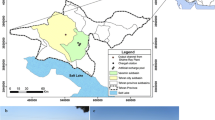Abstract
The reuse of nutrients and organic matter in wastewater sludge via on agricultural lands application is a desirable goal. However, trace or heavy metals present in sludge pose the risk of human or phytotoxicity from land application. The aim of this research is possibility of ground water pollution of south of Tehran because of ten years irrigation with Ni, Cd and Pb borne waste water. For this purpose, 6 soil samples from southern parts of Tehran city and 2 ones from Zanjan city without lime and organic matter were selected. The soils differed in their texture from sandy to clayey. Each soil sample in duplicate and uniformly packed into PVC columns. Soil samples were irrigated with Cd, Pb and Ni-added wastewater. After irrigating, the columns were cut and the soils separated from sectioned pieces and their heavy metal concentrations (Pb, Cd and Ni) were measured by atomic absorption spectrophotometer by use of HNO3 4N solution. Because of high sorption capacity of these elements by soils, these metals were accumulated in surface layer of the soils. Movement in the soils without lime and organic matter were as low as other samples. Ni has had the most accumulation or the least vertical movement, and Pb the opposite ones.
Similar content being viewed by others
References
Black, C. A., (1965). Methods of soil analysis, Part 2. 2ed. Ed, Agronomy Monog., ASA, Madison, WI. 9
Corey, J. E., (1987). Metal movement in sludge amended soils, Soil Sci., 143(2), 124–131.
Dorronsoro, C. and Martin, F., (2002). Migration of trace elements from pyrite tailings in carbonate soils. J. Env. Qual., 31(1), 829–835.
Emmerich, W. E., Lund, L. J. and Page, A. L., (1982a). Movement of heavy metals in sewage sludge-treated soils. J. Env. Qual., 11, 174–178.
Emmerich, W. E., Lund, L. J. and Page, A. L., (1982b). Solid phase forms of heavy metals in sewage sludge-treated soils. J. Env. Qual., 11(2), 178–181.
Monday, O. M., Thompson M. L. and Larid, D. A., (2001). Disribution and movement of sludge derived trace metals in selected Nigerian soils. J. Env. Qual., 30(1). 1667–1674.
Page, A. L., (1965). Methods of soil analysis, Part 1. 2ed. Ed, Agronomy Monog., ASA, Madison, WI. 9
Richards, B. K. and McBride, M. B., (1983). Metal mobility at an old heavily loaded sludge application site. Environ. Poll., 99(2), 365–377.
Smith, S. R., (1996). Agricultural recycling of sewage sludge and the environment. CAB International, UK.
Udom, B. E. and Mbagwu, J. S. C. (2004). Distribution of Zn, Cu, Cd, and Pb in a tropical ultisolsol after long-term disposal of sewage sludge. Environ. Int., 4(2), 467–470.
Williams, D. E., Vlamis, J., Pukite, A. H. and Corey, J. E., (1980). Trace element accumulation, movement, and distribution in the soil profile from massive applications of sewage sludge. Soil Sci., 129(3), 119–132.
Williams, D. E., Vlamis, J., Pukite, A. H. and Corey, J. E., (1984). Metal movement in sludge treated soils after six years of sludge addition. Soil Sci., 137(2), 351–359.
Author information
Authors and Affiliations
Corresponding author
Rights and permissions
About this article
Cite this article
Salmasi, R., Tavassoli, A. Pollution of south of Tehran ground waters with heavy metals. Int. J. Environ. Sci. Technol. 3, 147–152 (2006). https://doi.org/10.1007/BF03325918
Received:
Revised:
Accepted:
Published:
Issue Date:
DOI: https://doi.org/10.1007/BF03325918




